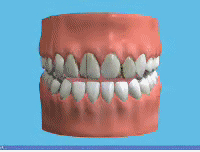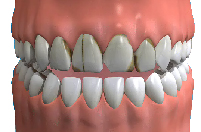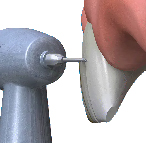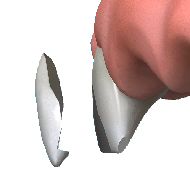 A veneer is a thin layer of porcelain which is bonded over the front face of a tooth. It is similar to a false fingernail and can transform a stained or unsightly tooth into a perfect looking tooth. These can be an ideal cosmetic face-lift for your smile and are often fitted to more than one tooth at a time for optimum results.
A veneer is a thin layer of porcelain which is bonded over the front face of a tooth. It is similar to a false fingernail and can transform a stained or unsightly tooth into a perfect looking tooth. These can be an ideal cosmetic face-lift for your smile and are often fitted to more than one tooth at a time for optimum results.
FAQs about Veneers
What is a veneer?
 A veneer is a thin layer of porcelain made to fit over the front surface of a tooth, like a false fingernail fits over a nail. Sometimes a natural colour ‘composite’ material is used instead of porcelain.
A veneer is a thin layer of porcelain made to fit over the front surface of a tooth, like a false fingernail fits over a nail. Sometimes a natural colour ‘composite’ material is used instead of porcelain.
What are the advantages of veneers?
Veneers make teeth look natural and healthy, and because they are very thin and are held in place by a cement less preparation of the tooth is needed than for a full coverage crown.
When would I need a veneer?
 Veneers can improve the colour, shape and perception of teeth. A precise shade of porcelain can be chosen to give the right colour to improve a single discoloured or stained tooth or to lighten front teeth (usually the upper ones). A veneer can make a chipped tooth look intact again. The porcelain covers the whole of the front of the tooth with a thicker section replacing the broken part. Veneers can also be used to close small gaps, when orthodontics (braces) are not suitable. If one tooth is slightly out of position, a veneer can sometimes be fitted to bring it into line with the others.
Veneers can improve the colour, shape and perception of teeth. A precise shade of porcelain can be chosen to give the right colour to improve a single discoloured or stained tooth or to lighten front teeth (usually the upper ones). A veneer can make a chipped tooth look intact again. The porcelain covers the whole of the front of the tooth with a thicker section replacing the broken part. Veneers can also be used to close small gaps, when orthodontics (braces) are not suitable. If one tooth is slightly out of position, a veneer can sometimes be fitted to bring it into line with the others.
What about alternatives?
A natural-coloured filling material can be used for minor repairs to front teeth. This is excellent where the tooth supports the filling, but may not work so well for broken tooth corners. There will always be a join between the tooth and the filling material.
Crowns are used for teeth that need to be strengthened – either because they have broken, have been weakened by a very large filling, or have had root canal treatment.
How long will a veneer last?
 Veneers should last for many years, but they can chip or break, just as your own teeth can. Small chips can be repaired, or a new veneer fitted if necessary. Care needs to be taken with veneers, as they can ping off should they be used inappropriately.
Veneers should last for many years, but they can chip or break, just as your own teeth can. Small chips can be repaired, or a new veneer fitted if necessary. Care needs to be taken with veneers, as they can ping off should they be used inappropriately.
How are teeth prepared for a veneer?
Some of the shiny outer enamel surface of the tooth may be removed, to make sure that the veneer can be bonded permanently in place later. The amount of enamel removed is about a millimeter and will be the same as the thickness of the veneer to be fitted, so that the tooth stays the same size. A local anaesthetic (injection) may be used to make sure that there is no discomfort.
Once the tooth has been prepared, the dentist will take an ‘impression’. This will be given to the dental technician, along with any other information needed to make the veneer. The colour of the surrounding teeth is matched on a shade guide to make sure that the veneer will look entirely natural.






